余海波
1962年出生,河南省永城县人。自幼师从画家杨振洲先生,曾服役,军旅中在中国美术学院随张怀江先生学版画。1989年毕业于武汉大学摄影专业;现居住深圳。系深圳报业集团《深圳商报》摄影总监;深圳市职业摄影协会会长;深圳大学客座教授。
其作品曾获1986年《远古的梦》国际和平年全国摄影大奖赛最高奖“国际和平杯”;2005年国际新闻摄影比赛金奖;2006年国际新闻摄影比赛金奖;2006年第49届“荷赛”艺术类二等奖;第九届“中国摄影金像奖”;中国新闻奖;鲁迅艺术奖;中国摄影记者“金眼奖”;全国“十佳青年摄影记者”;中国摄影50年贡献奖等。
获奖:
1986年《远古的梦》获国际和平年全国摄影大奖赛最高奖—“国际和平杯”;
1986年《远古的梦》获全国“十大杰作”奖;
1988年《在幻想锁链的彼岸》(系列)第15届全国影展“艺术风格”大奖;
1989年 获首届中国摄影金像奖提名;
1999年 获中国摄影记者“金眼奖”;
2001年 获全国十佳青年摄影记者;
2005年《深圳青年的音乐冲动》(组照)获国际新闻摄影比赛艺术类金奖;
2006年 中国新闻奖;
2006年《大芬油画村》(组照)获第49届世界新闻摄影比赛艺术类二等奖;
2006年《大芬油画村》(组照)国际新闻摄影比赛艺术类金奖;
2010年 中国摄影50年贡献奖;
2011年 鲁迅艺术奖;
2012年 第九届中国摄影金像奖;
展览:
2015年《无语的风景》魔力当代艺术展(深圳);
2014年《无语的风景》置换--界内界外当代艺术展(深圳);
2014年《洞察》深圳大学美术馆摄影个展(深圳);
2013年 《中国矿工》沈阳国际工业摄影节个展(沈阳);
2013年 中国摄影家6人美国巡展(美国);
2013年 《通途》深港黑白摄影联展(深圳);
2012年 《城市的距离》济南国际摄影双年展个展(济南);
2012年 连州国际摄影节个展(连州);
2012年 《大芬油画村》纽约“腾飞的巨龙”中国当代艺术精品展(纽约);
2011年《大芬油画村》美国旧金山现代艺术博物馆75年典藏展(旧金山);
2011年“冰十煤”国际当代影像休斯顿、纽约、北京巡展(休斯顿、纽约、北京);
2010年《一半是海水一半是火焰》北京798艺术区大河画廊个展(北京);
2010年 西安美术馆中国20位纪实摄影家作品展览(西安);
2009年 《大芬油画村》瑞士苏黎世民族博物馆展览(苏黎世);
2008年《大芬油画村》(系列)北京宋庄当代艺术展(北京);
2008年《夜晚的呼吸》(系列)美国俄克拉荷马州大学弗雷德.钟斯美术馆(美国);
2008年 《大芬油画村》波兰国际摄影节展览(波兰);
2008年《矿工家庭》(系列)美国休斯顿展出(美国休斯顿);
2008年《延伸的距离》85以来广东当代艺术展(广州);
2008年《大芬油画村》法国文化遗产展(巴黎);
2007年《通途》英国V&A博物馆“中国设计展”(伦敦);
2007年 德国“中国摄影家十人展” (慕尼黑);
2005年 平遥国际摄影节摄影个展(平遥);
1999年《在幻想锁链的彼岸》(系列)界内界外当代艺术展(深圳)
1994年 德国《在城市那方—中国乡村景观》摄影联展(慕尼黑);
1989年《对活》中国摄影家优秀作品赴日本展览(东京);
1988年《在幻想锁链的彼岸》(系列)第15届全国影展(北京);
1987年《远古的梦》中国摄影摄影家优秀作品赴欧洲巡回展览(法国、意大利、德国等);
1985年《远古的梦》第13届全国摄影艺术展览(北京);
出版;
2009年 主编《纹川.记忆之谷》摄影画册(海天出版社);
2007年《生活在改革开放的中国深圳》摄影专集(中国摄影出版社)
2007年 主编《吾城吾乡》摄影年展作品集(海天出版社);
收藏;
2014年 《大芬油画村》美国克兰纳特美术馆收藏;
2012年 《移民档案》关山月美术馆收藏;
2012年 《无语的风景》关山月美术馆收藏;
2007年 《大芬油画村》(系列)美国旧金山现代艺术博物馆收藏;
2007年 《通途》关山月美术馆收藏;
2007年 《大芬油画村》深圳美术馆收藏;
2007年 《大芬油画村》当代中国摄影百家典藏;
Yu Haibo
Born in 1962, in Yongcheng County, Henan. Studied painting with Mr Yang Zhenzhou, joined military, during the time, studied printmaking with Mr. Zhang Huaijiang in China academy of fine arts. In 1989, he graduated from wuhan university photography and currently lives in Shenzhen. Serves as director of photography at "shenzhen business newspaper"; president of Shenzhen professional photography association; guest professor at Shenzhen University.
Awards
“Ancient Dreams” China Peace Year Photography Competition
“Ancient Dreams”National “Ten Outstanding Photography”Award
“”The Fifteenth National Photography “Style”Award
The First China Photography Gold Figure Award
Chinese photojournalists “golden eye”award
national outstanding young photojournalist
international new photography competition
China News Photo Award
second prize of the 49th international news photography competition
China Photography 50 Years Contribution Award
Luxun Art Prize
The Ninth China Photography Gold Figure Award
Exhibitions
“Wordless Scenery” Magic Comtemporay Art Exhibition, Shenzhen
“Wordless Scenery”, Exchange Contemporary Art Exhibition, Shenzhen
“Insight” Shenzhen University Art Gallery
“Chinese Miners”Shenyang International Industrial Photography, Shenyang Six Chinese Photographers Touring Exhibition, USA
“Open Path”Shenzhen and Hongkong Black and White Exhibition, Shenzhen Distance Between Cities, Jinan International photography Biennale, Jinan
Lianzhou International Photography Festival
“Dafen Oil Painting Village: Chinese Contemporary Art Exhibition”, New York
“Dafen Oil Painting Village”75 Years Celebration of San Francisco Modern Art Museum”, San Francisco
“Ice and Mine”International Contemporary Images Exhibition, Huston, New York, Beijing
“A half of seawater and a half of fire”798 Art district, Dahe Gallery, Beijing
20 Chinese documentary Photographers group exhibition ,Xian’an Art Museum
“Dafen Oil Painting Village”, Zurich
“Dafen Oil Painting Village”, Song Village, Beijing
“Breath at Night” Oklahoma State University gallery, USA
“Dafen Oil Painting Village”, Portland International Photography Festivel “Miner families” Huston, USA
Contemporary art in Guangdong after 1985, guangzhou
“Dafen Oil Painting Village”, france cultural heritage exhibition, paris
“open path” British V&A museum, London
Germany 10 Chinese Photographers Group Exhibition
Pingyao International Photography festival
“in the cities—Chinese rural scenery”Germany Group exhibition, Munich
“Conversation”Traveling exhibition of excellent Chinese photographic work
Ancient dreams”, traveling exhibition of excellent Chinese photographers’ work in Europe, France , Italy, German
Ancient dreams, the 13th national photography art exhibition, beijing
Publications
“Wenchuan—vallery of memories”, Haitian press
“Living in the Shenzhen”, China Photography Publishing House
Our city our hometown, Haitian press
Awards
“Dafen Oil Painting Village”, Krannert Art Museum, Illinois, USA
“Immigration Archive“ Shenzhen guanshanyue art gallery
Wordless scenery, Shenzhen guanshanyue art gallery
“Dafen Oil Painting Village”, Modern art museum of San Francisco
“Dafen Oil Painting Village”, Shenzhen Museum of Art
“Dafen Oil Painting Village” 100 Contemporary Chinese photographers collection
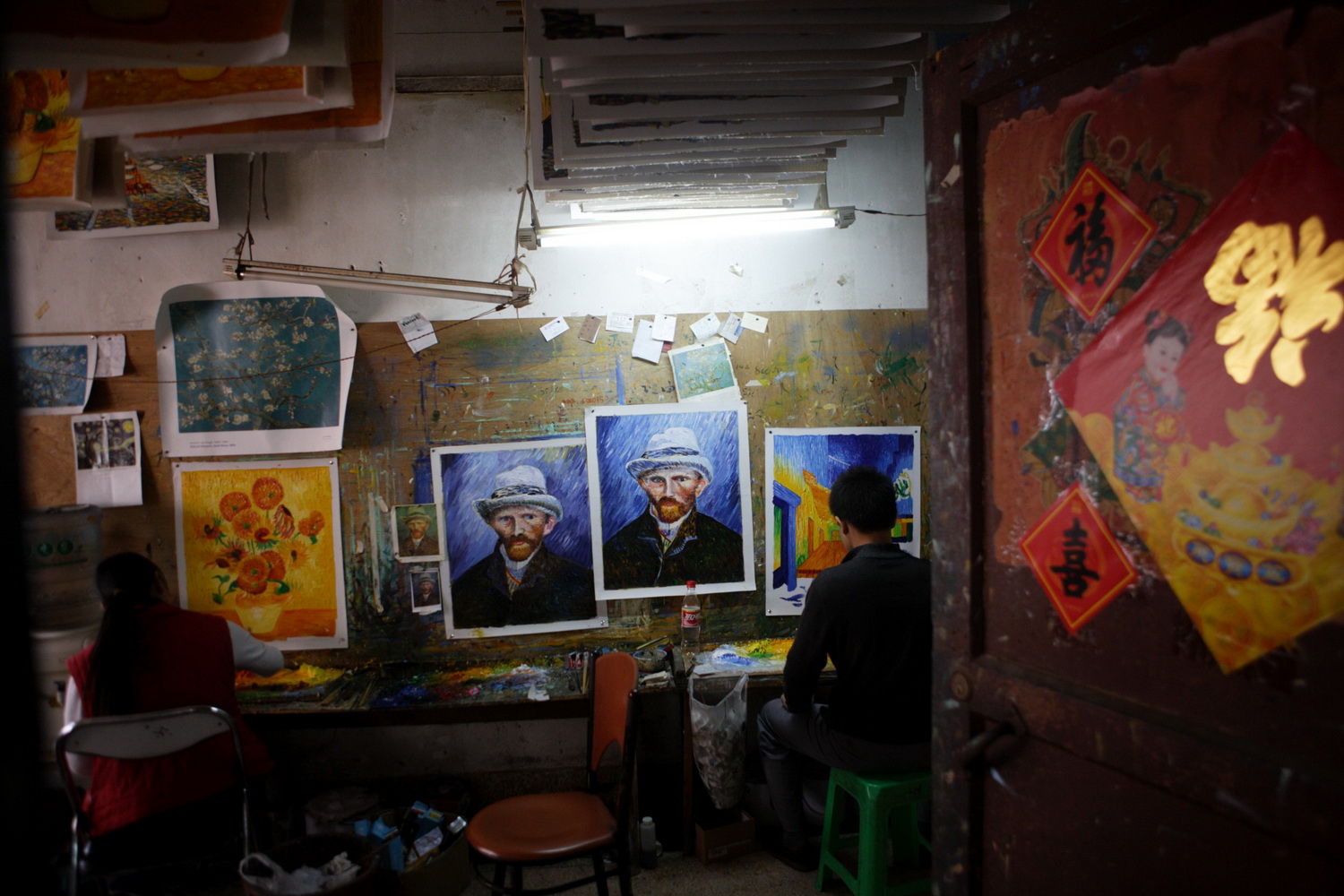
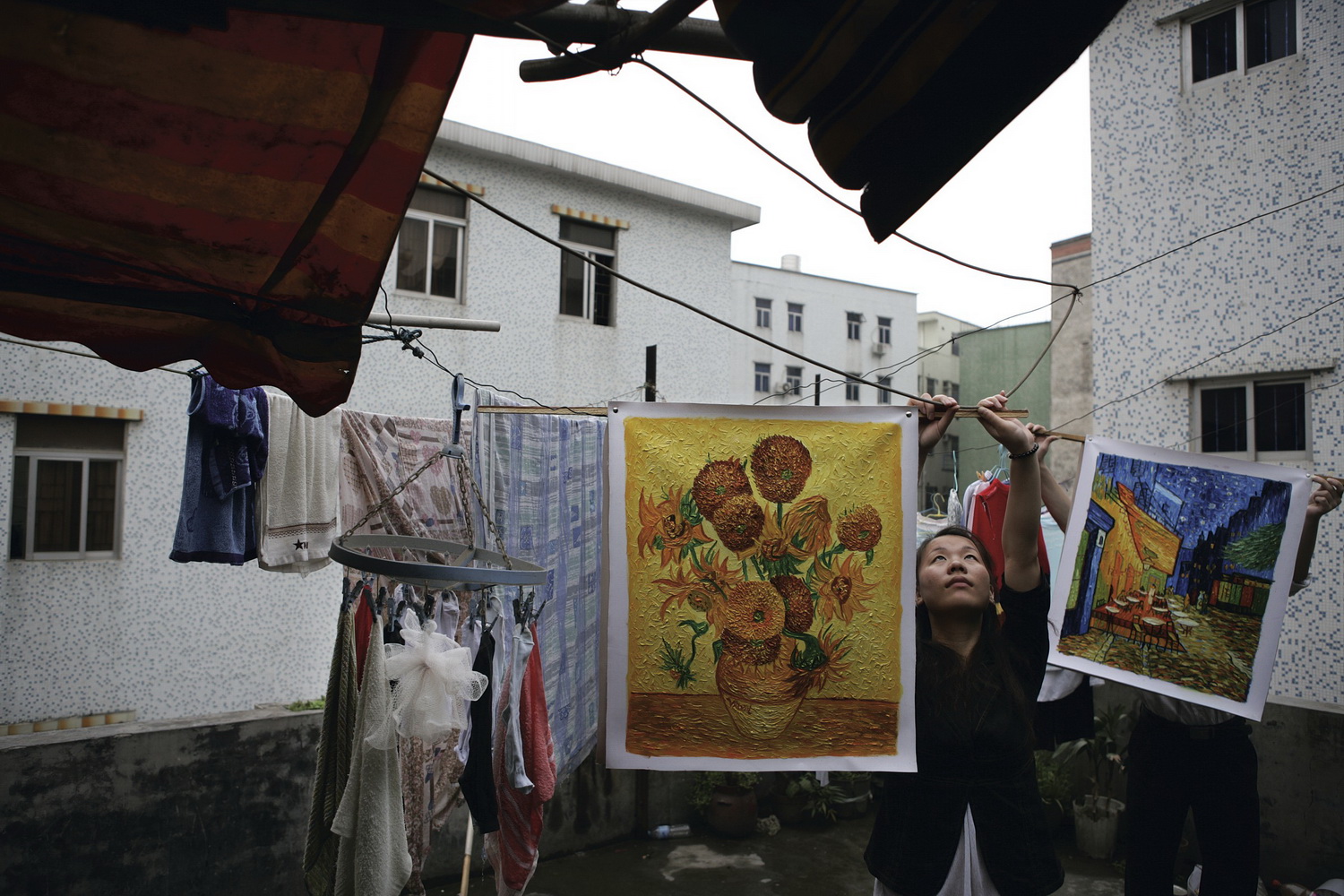
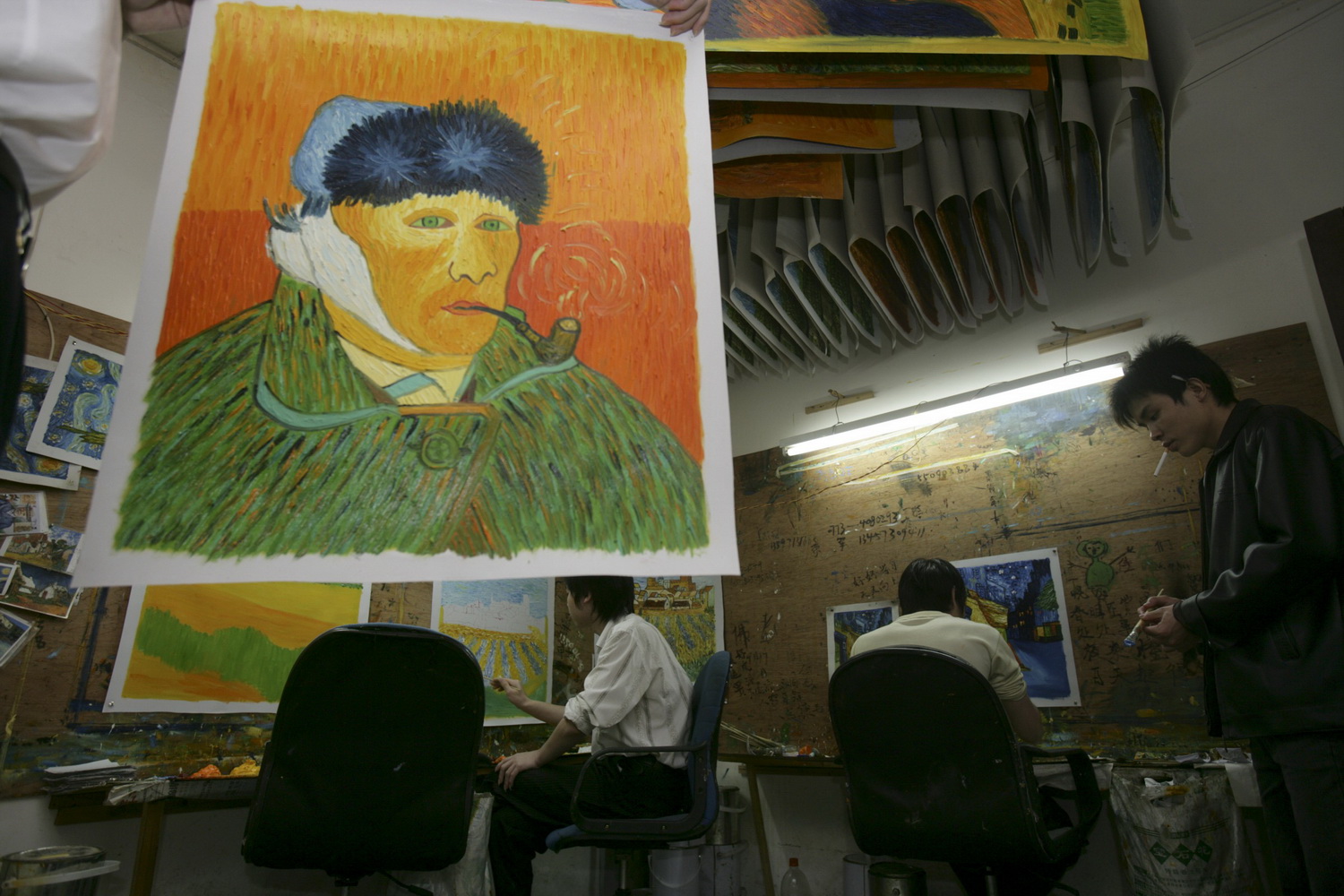
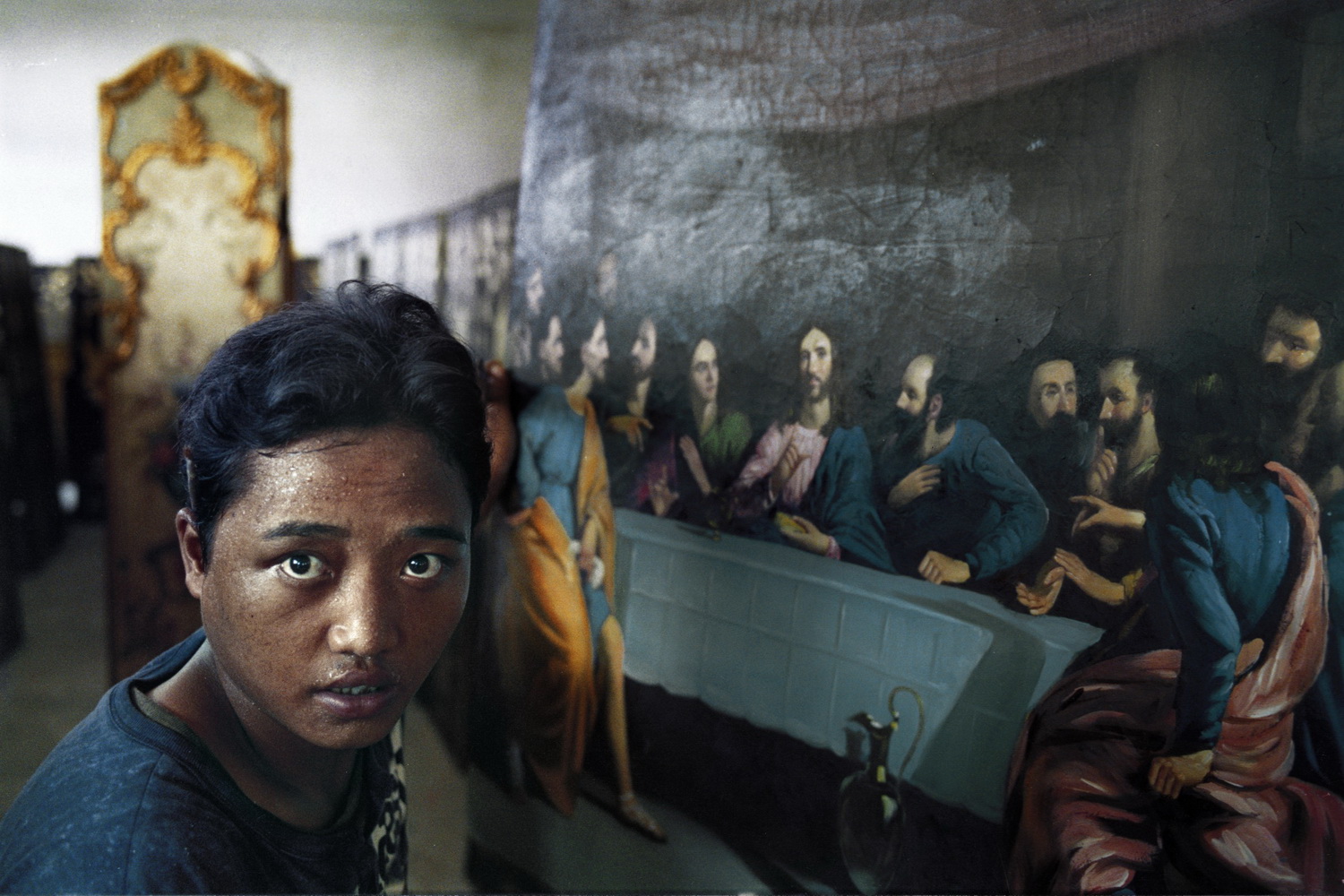
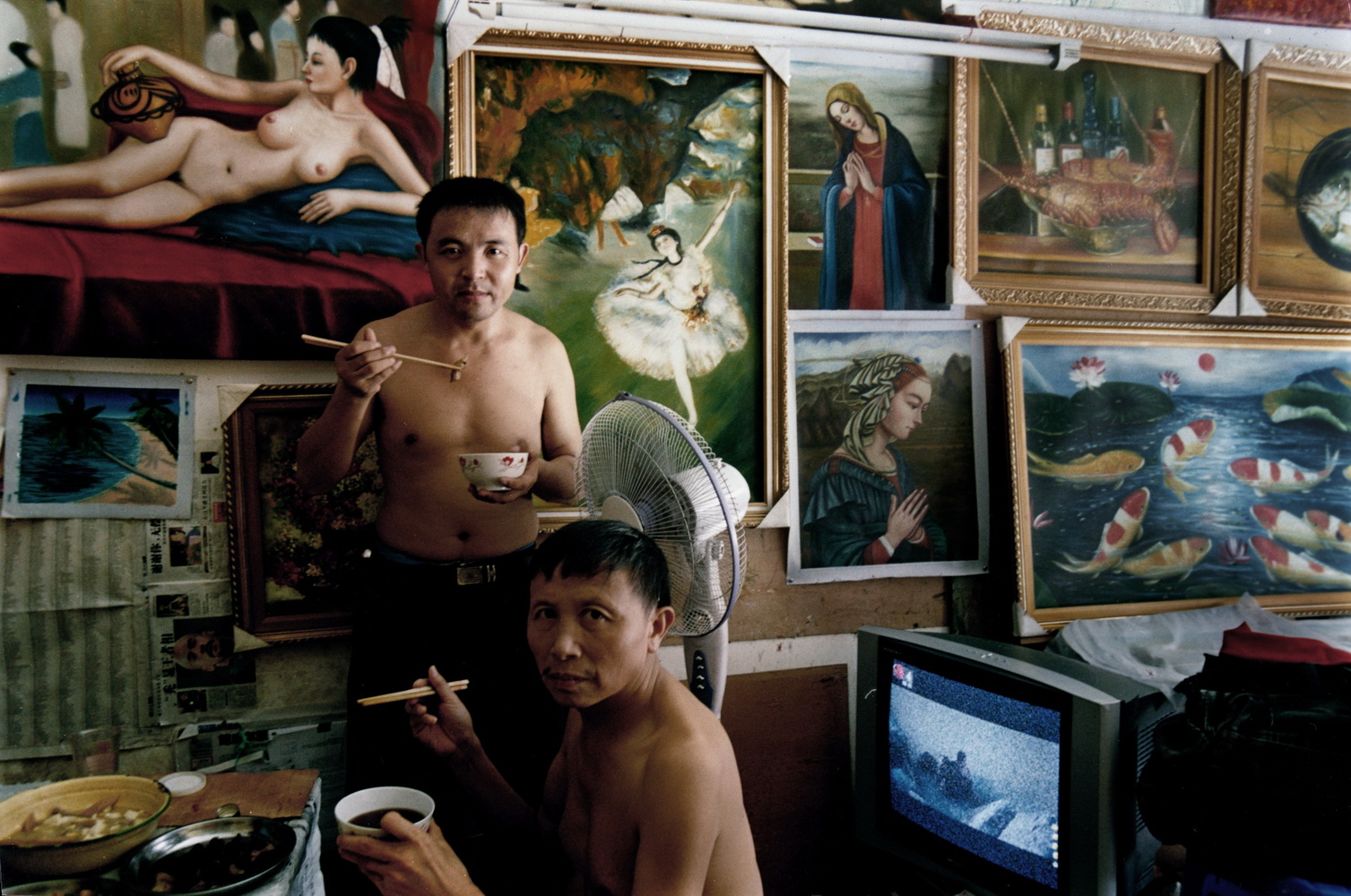
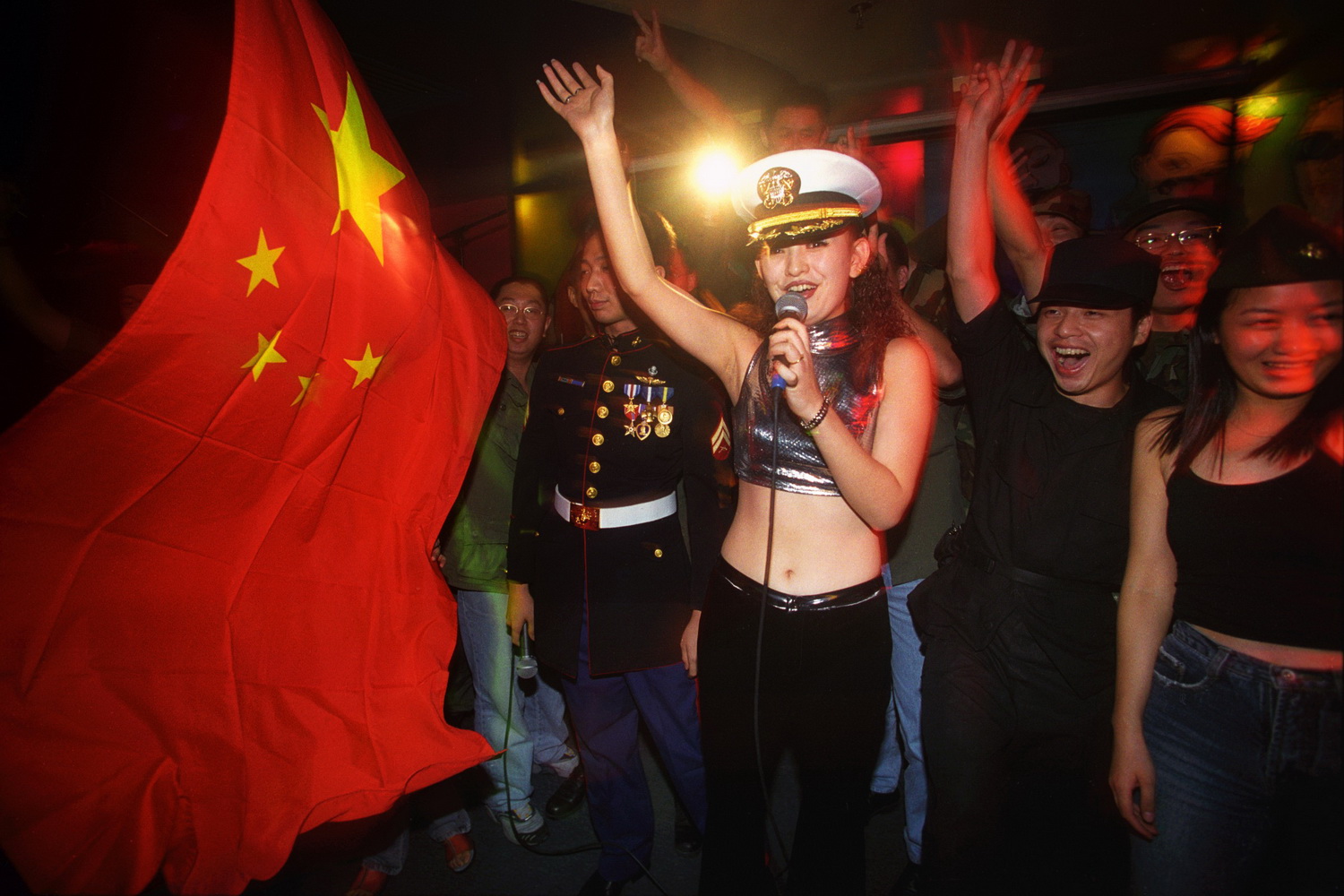
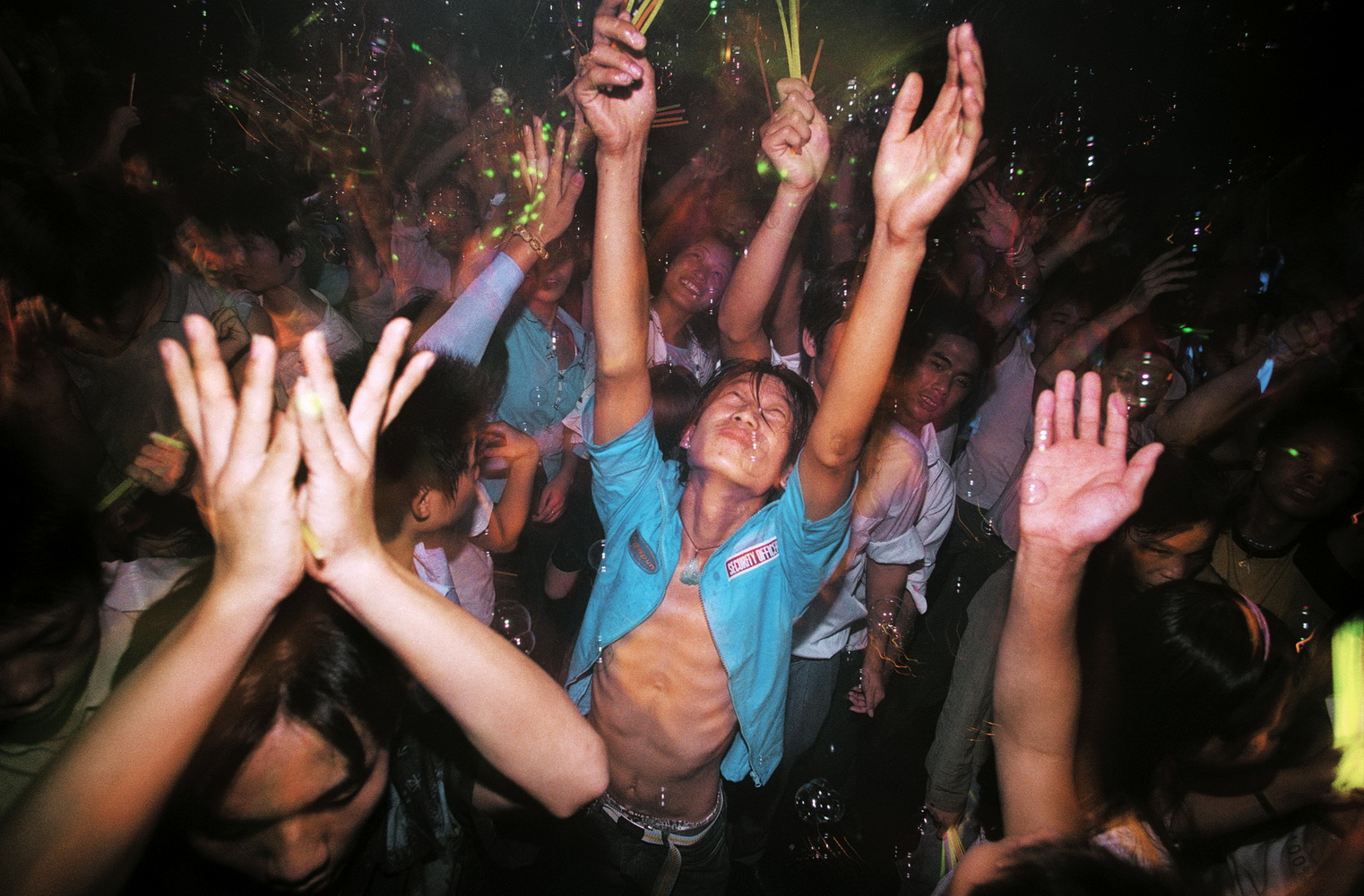
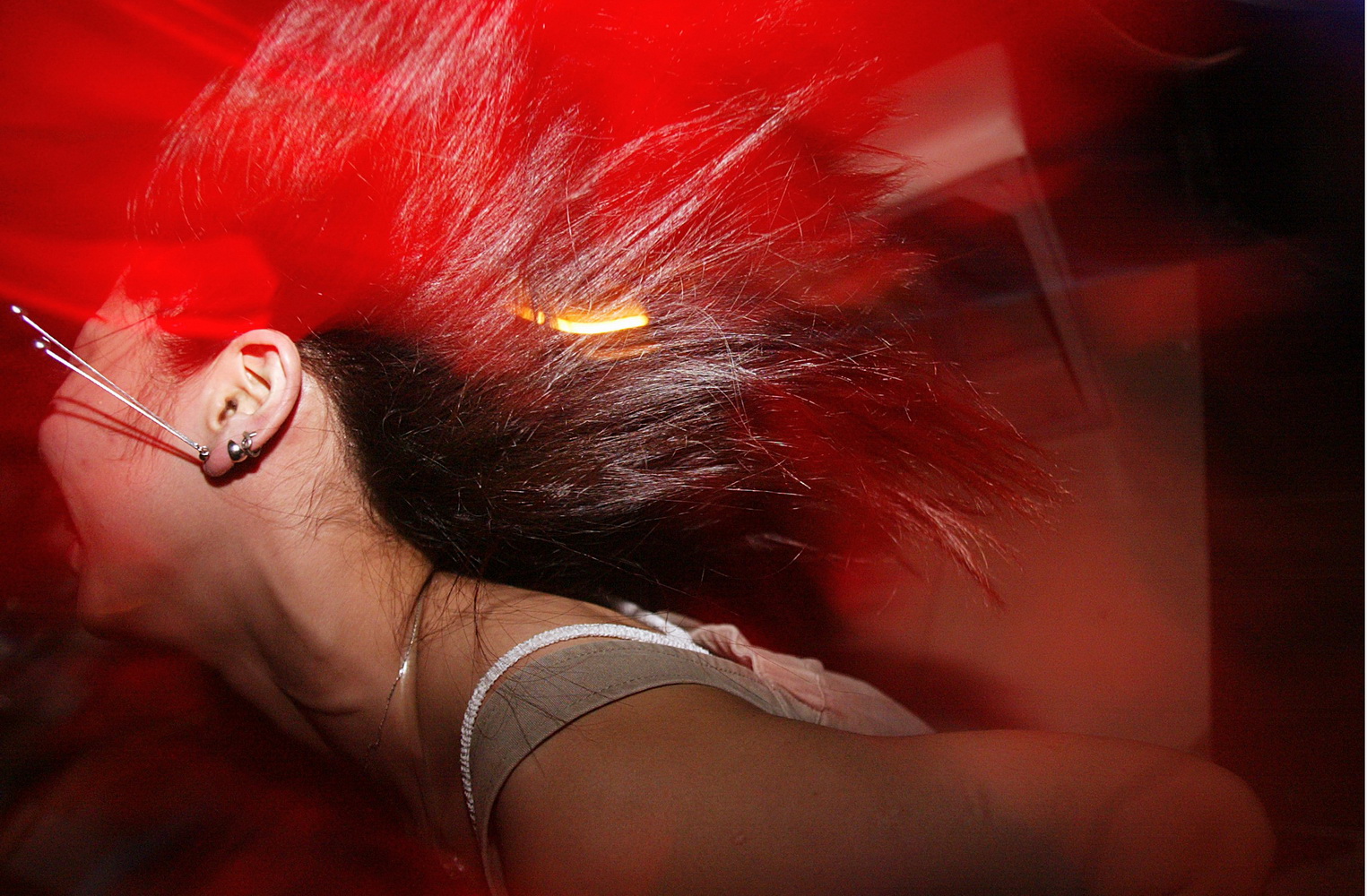
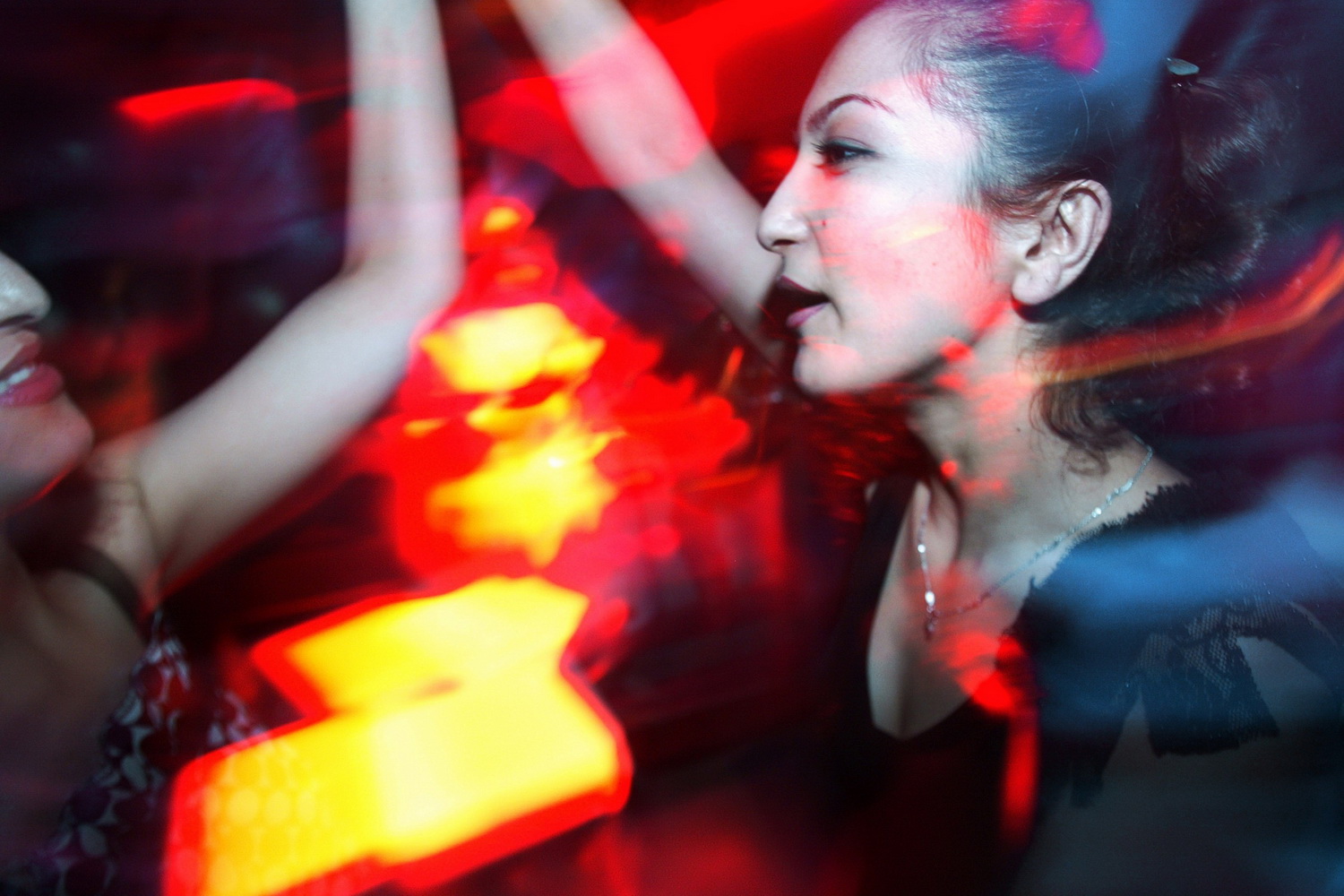
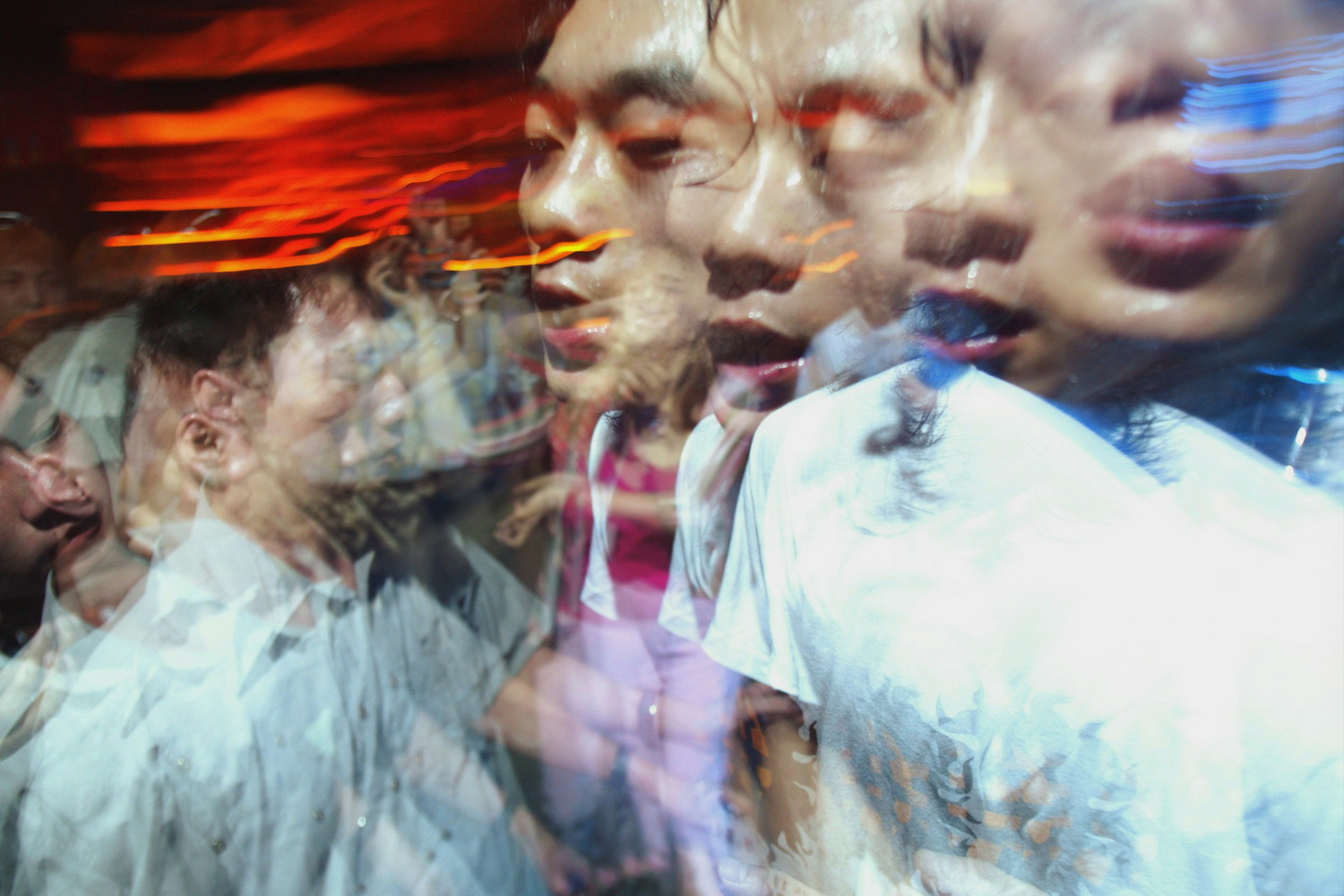
Yu Haibo spent seven months tracing the magically radiant oil industry chain of Dafen Oil Painting Village in Shangzhen, and revealed an inside story of the market occupying over sixty percent in global. During the seven months, he spent all his time with those painters in Dafen village. He recalled the scene for the first time entered the studios; Yu Haibo said he was deeply shocked. "It was hot, they were in the gaps among these paintings, barebacked, quietly, quietly, day after day painted. I was unable to move for at least ten minutes, quietly stood still and watching them, until I feel my temperature and gradually approaching this strange environment, then I started shooting. "
The first time I heard about Yu Haibo for his <Ancient Dream>, which rewarded by the Global Peace reward in 1986’s Global Peace Year Photography Competition. This piece of work is full of a vigorous sense of historical works, showing his using photography as an intermediary and expands humanistic thinking and explores photographic language traits as a double interest. And this is also the time that the Chinese Modern Photography embarks on a colorful way. Yu Haibo echoed his photographic experiments of this wave of this movement in photography.
His "The Fantasy Side Chains" (8) that published in 1988, also demonstrated his ability to innovate and vitality. This series organized a variety of contradictions, conflicts of visual material into a philosophical and fantasy colors, reflect his sensibility and excellent performance of a youth facing life and rich history. As a result, it became the 15th National Photography Exhibition "personal style" works of the highest category award. It is a most "modernity" photography work in China.
Photomontage, which is invented in the western world, has not been much used in China, neither was expanded further experiments in artistic expression, nor theory researches. However, as a non-traditional painting technique that consistent with the rule of perspective, Photomontage played a very important role in the 20th century. As a visual sense of production, photomontage and film montage, collage painting, literature stream of consciousness has become a natural means of legitimacy "collage", has exactly the same concept.
However, in China, there were some deconcentrated explorations on some publications included illustrated magazines in 1930s, but not for a pure artistic expression. Therefore, photomontage in photography's evolution is a blank in the history of Chinese modern photography. Yu Xiubo’s belated series fills the blank of the history of Chinese modern photography, which also a great symbolic.
As a person who also was obsessed with experimental photography as myself, it is sad that I don't have a chance of direct communication with Yu Haibo. However, I kept paying attention to his new experiments. During the time in China, it is valuable that young photographers who spending time experiencing technologies. Some of them are limited of times and realities, then became narrow and shallow. Yu Haibo‘s practice, especially in the use of photography to explore the art of montage expand on this point, in terms of attitudes or practices point of view, can be said to be the most complete, most skilled, and most successful works. Therefore, he was known by many young people's attention, which is taken for granted.
However, interestingly, just as people expect him to spend more time making experimental works, Haibo, as a photojournalism graduate, decided to quit, farewell to the avant-garde experiment, move to Shenzhen, immersed in documentary photography and photojournalism.
From all perspective, documentary and photojournalism is the contrary of his avant-garde experiment. Documentary and photojournalism are not about imaginations, it’s a is subject related to realities - most are man-made or even outrageous, ridiculous, which is highly realistic, it‘s not a "imagine" visual communication. Obviously, it is a huge challenge for Yu Haibo.
In the past 10 years, Yu Haibo has spent his time traveling around China, reported the changes in the country through his eyes. His works allowed us to meet all those different people would only see after the reform and opening up in China. His series of the new immigrant of Shenzheng – “Thoroughfare” - was the earliest one that about this subject. Through his lens, we see the faces of the ancient civilization in the modern society, such as his "plateau of Tibet." He always paid his attention to those highly sensitive social issues and major issues of urbanization and social transformation that. For example, he shot a series of prostitutes in Shenzhen in 1995. As a Photojournalist, to witness major historical events in contemporary China is the bounden duty, he has covered events such as the reunification, and stationed special entry points from the People's Liberation Army Forces Hong Kong this to reflect the return of Hong Kong. His "Farewell pyramid schemes" led him to the honor "People Photography Newspaper" in 1998 Annual news no burst golden medal.
Which encouraged him most is the Culture and Art News Gold Award by 2005 First China International Press Photo Contest (SAI). His series "Shenzhen Youth Music impulses" showed the Chinese youth for bold pursuit of modern life. His flexible shooting style busted with new ideas in the color using, composition, capture and editing, fits the spirit and dynamic theme package. The news reports did practice a series of comprehensive attempt a holistic performance over the years.
Yu Haibo‘s photography series are, without exception, around the corners, from a unique perspective, to witness the changing times and revealing social issues. As he said, "The perspectives of a photographer are what his photographs are. Photographs about human life are what audience care about, those in the development process of the whole society has significant influence, arouse public interest and concern events, characters and other major news stories, the public side with their vital interests are closely related to social news stories, catastrophic themes, as well as news and the facts peculiar, full stories and humane subjects etc., have become the target photojournalist choice. "
Yu Haibo started from photographic experiment and ultimately to the objective documentary photography, the change of understanding the world and are his precious spiritual wealth.If his photographic experiments of his early time is the image dialogue of human civilized society, then he works in documentary photography and photojournalism is a call for closer observation of the real world around the world, it is his experiment of humanity for another sense of the depth of the anatomy.
Photojournalism is not the same communication way from Yu Haibo’s early avant-garde works. After his "Shenzhen Youth Music impulse" winning, he said: "I dislike shooting for forms. This is what I need to get rid of. I used to work like that, however, photojournalism is completely different, it is to record news events and newsmakers, should not be about the theme." He already have a new understanding of making photographs, his hates for those "themes" is an external form that only photographer gives himself to the reality of subjective and distorted, neither respect for the facts, not the facts tips Internal behind. The real form should beyond the external form, within the theme of being seen and not seen. In fact, for the excellent photographer or a good visual artist, after reaching a certain height Humanities and professional training, theme has no negative effects. He did not reject themes, even more demanding, and this demanding has already infiltrated into the photographer's visual unconscious and physiological instinct. In this case, theme has been an integral body, and has not abandoned, but should not be abandoned. In my opinion, Yu Haibo’s photography has contributed the theme. From photomontage’s collage to his series reflecting the social life, Yu Haibo has presented to us an new reality world, and a new visual world.
If his photographic experiments of his early time is the image dialogue of human civilized society, then he works in documentary photography and photojournalism is a call for closer observation of the real world around the world, it is his experiment of humanity for another sense of the depth of the anatomy.
Photojournalism is not the same communication way from Yu Haibo’s early avant-garde works. After his "Shenzhen Youth Music impulse" winning, he said: "I dislike shooting for forms. This is what I need to get rid of. I used to work like that, however, photojournalism is completely different, it is to record news events and Newsmakers, should not be about the theme." He already has a new understanding of making photographs, his hates for those "themes" is an external form that only photographer gives himself to the reality of subjective and distorted, neither respect for the facts, not the facts tips Internal behind. The real form should beyond the external form, within the theme of being seen and not seen. In fact, for the excellent photographer or a good visual artist, after reaching a certain height Humanities and professional training, theme has no negative effects. He did not reject themes, even more demanding, and this demanding has already infiltrated into the photographer's visual unconscious and physiological instinct. In this case, the theme has been an integral body, and has not abandoned, but should not be abandoned. In my opinion, Yu Haibo’s photography has contributed the theme. From photomontage collage of his series reflecting the social life, Yu Haibo has presented to us a new reality world, and a new visual world.
1962年出生,河南省永城县人。自幼师从画家杨振洲先生,曾服役,军旅中在中国美术学院随张怀江先生学版画。1989年毕业于武汉大学摄影专业;现居住深圳。系深圳报业集团《深圳商报》摄影总监;深圳市职业摄影协会会长;深圳大学客座教授。
其作品曾获1986年《远古的梦》国际和平年全国摄影大奖赛最高奖“国际和平杯”;2005年国际新闻摄影比赛金奖;2006年国际新闻摄影比赛金奖;2006年第49届“荷赛”艺术类二等奖;第九届“中国摄影金像奖”;中国新闻奖;鲁迅艺术奖;中国摄影记者“金眼奖”;全国“十佳青年摄影记者”;中国摄影50年贡献奖等。
获奖:
1986年《远古的梦》获国际和平年全国摄影大奖赛最高奖—“国际和平杯”;
1986年《远古的梦》获全国“十大杰作”奖;
1988年《在幻想锁链的彼岸》(系列)第15届全国影展“艺术风格”大奖;
1989年 获首届中国摄影金像奖提名;
1999年 获中国摄影记者“金眼奖”;
2001年 获全国十佳青年摄影记者;
2005年《深圳青年的音乐冲动》(组照)获国际新闻摄影比赛艺术类金奖;
2006年 中国新闻奖;
2006年《大芬油画村》(组照)获第49届世界新闻摄影比赛艺术类二等奖;
2006年《大芬油画村》(组照)国际新闻摄影比赛艺术类金奖;
2010年 中国摄影50年贡献奖;
2011年 鲁迅艺术奖;
2012年 第九届中国摄影金像奖;
展览:
2015年《无语的风景》魔力当代艺术展(深圳);
2014年《无语的风景》置换--界内界外当代艺术展(深圳);
2014年《洞察》深圳大学美术馆摄影个展(深圳);
2013年 《中国矿工》沈阳国际工业摄影节个展(沈阳);
2013年 中国摄影家6人美国巡展(美国);
2013年 《通途》深港黑白摄影联展(深圳);
2012年 《城市的距离》济南国际摄影双年展个展(济南);
2012年 连州国际摄影节个展(连州);
2012年 《大芬油画村》纽约“腾飞的巨龙”中国当代艺术精品展(纽约);
2011年《大芬油画村》美国旧金山现代艺术博物馆75年典藏展(旧金山);
2011年“冰十煤”国际当代影像休斯顿、纽约、北京巡展(休斯顿、纽约、北京);
2010年《一半是海水一半是火焰》北京798艺术区大河画廊个展(北京);
2010年 西安美术馆中国20位纪实摄影家作品展览(西安);
2009年 《大芬油画村》瑞士苏黎世民族博物馆展览(苏黎世);
2008年《大芬油画村》(系列)北京宋庄当代艺术展(北京);
2008年《夜晚的呼吸》(系列)美国俄克拉荷马州大学弗雷德.钟斯美术馆(美国);
2008年 《大芬油画村》波兰国际摄影节展览(波兰);
2008年《矿工家庭》(系列)美国休斯顿展出(美国休斯顿);
2008年《延伸的距离》85以来广东当代艺术展(广州);
2008年《大芬油画村》法国文化遗产展(巴黎);
2007年《通途》英国V&A博物馆“中国设计展”(伦敦);
2007年 德国“中国摄影家十人展” (慕尼黑);
2005年 平遥国际摄影节摄影个展(平遥);
1999年《在幻想锁链的彼岸》(系列)界内界外当代艺术展(深圳)
1994年 德国《在城市那方—中国乡村景观》摄影联展(慕尼黑);
1989年《对活》中国摄影家优秀作品赴日本展览(东京);
1988年《在幻想锁链的彼岸》(系列)第15届全国影展(北京);
1987年《远古的梦》中国摄影摄影家优秀作品赴欧洲巡回展览(法国、意大利、德国等);
1985年《远古的梦》第13届全国摄影艺术展览(北京);
出版;
2009年 主编《纹川.记忆之谷》摄影画册(海天出版社);
2007年《生活在改革开放的中国深圳》摄影专集(中国摄影出版社)
2007年 主编《吾城吾乡》摄影年展作品集(海天出版社);
收藏;
2014年 《大芬油画村》美国克兰纳特美术馆收藏;
2012年 《移民档案》关山月美术馆收藏;
2012年 《无语的风景》关山月美术馆收藏;
2007年 《大芬油画村》(系列)美国旧金山现代艺术博物馆收藏;
2007年 《通途》关山月美术馆收藏;
2007年 《大芬油画村》深圳美术馆收藏;
2007年 《大芬油画村》当代中国摄影百家典藏;
Yu Haibo
Born in 1962, in Yongcheng County, Henan. Studied painting with Mr Yang Zhenzhou, joined military, during the time, studied printmaking with Mr. Zhang Huaijiang in China academy of fine arts. In 1989, he graduated from wuhan university photography and currently lives in Shenzhen. Serves as director of photography at "shenzhen business newspaper"; president of Shenzhen professional photography association; guest professor at Shenzhen University.
Awards
“Ancient Dreams” China Peace Year Photography Competition
“Ancient Dreams”National “Ten Outstanding Photography”Award
“”The Fifteenth National Photography “Style”Award
The First China Photography Gold Figure Award
Chinese photojournalists “golden eye”award
national outstanding young photojournalist
international new photography competition
China News Photo Award
second prize of the 49th international news photography competition
China Photography 50 Years Contribution Award
Luxun Art Prize
The Ninth China Photography Gold Figure Award
Exhibitions
“Wordless Scenery” Magic Comtemporay Art Exhibition, Shenzhen
“Wordless Scenery”, Exchange Contemporary Art Exhibition, Shenzhen
“Insight” Shenzhen University Art Gallery
“Chinese Miners”Shenyang International Industrial Photography, Shenyang Six Chinese Photographers Touring Exhibition, USA
“Open Path”Shenzhen and Hongkong Black and White Exhibition, Shenzhen Distance Between Cities, Jinan International photography Biennale, Jinan
Lianzhou International Photography Festival
“Dafen Oil Painting Village: Chinese Contemporary Art Exhibition”, New York
“Dafen Oil Painting Village”75 Years Celebration of San Francisco Modern Art Museum”, San Francisco
“Ice and Mine”International Contemporary Images Exhibition, Huston, New York, Beijing
“A half of seawater and a half of fire”798 Art district, Dahe Gallery, Beijing
20 Chinese documentary Photographers group exhibition ,Xian’an Art Museum
“Dafen Oil Painting Village”, Zurich
“Dafen Oil Painting Village”, Song Village, Beijing
“Breath at Night” Oklahoma State University gallery, USA
“Dafen Oil Painting Village”, Portland International Photography Festivel “Miner families” Huston, USA
Contemporary art in Guangdong after 1985, guangzhou
“Dafen Oil Painting Village”, france cultural heritage exhibition, paris
“open path” British V&A museum, London
Germany 10 Chinese Photographers Group Exhibition
Pingyao International Photography festival
“in the cities—Chinese rural scenery”Germany Group exhibition, Munich
“Conversation”Traveling exhibition of excellent Chinese photographic work
Ancient dreams”, traveling exhibition of excellent Chinese photographers’ work in Europe, France , Italy, German
Ancient dreams, the 13th national photography art exhibition, beijing
Publications
“Wenchuan—vallery of memories”, Haitian press
“Living in the Shenzhen”, China Photography Publishing House
Our city our hometown, Haitian press
Awards
“Dafen Oil Painting Village”, Krannert Art Museum, Illinois, USA
“Immigration Archive“ Shenzhen guanshanyue art gallery
Wordless scenery, Shenzhen guanshanyue art gallery
“Dafen Oil Painting Village”, Modern art museum of San Francisco
“Dafen Oil Painting Village”, Shenzhen Museum of Art
“Dafen Oil Painting Village” 100 Contemporary Chinese photographers collection










从超现实到人间世相
----余海波的摄影之路
顾铮
余海波在2005年用了七个月的时间追踪拍摄深圳大芬油画村,系统地展现了一条20多年来神奇般辐射世界的油画产业链,揭开了一个占领全球60%以上油画市场份额奇迹的内幕。七个月内,几乎一有时间,他就去大芬村和画师们泡在一起,聊天、吃饭、睡觉,融入他们的生活。回忆起第一次进入大芬村画室时的情景,余海波说被深深地震撼了。“天气很热,他们就在这些画的间隙中,赤着背,默默地、静静地、日复一日地画着。我当时至少有十几分钟无法动弹,一直静静地站在原地注视他们,直到感觉到自己的温度与这奇异的环境逐渐接近,才能开始拍摄。”
最早知道余海波的名字是因为他那幅获得1986年国际和平年最高摄影奖项“国际和平杯”的《远古的梦》。这件充满了苍劲的历史感的作品,显示出余海波对于运用摄影媒介展开人文思考与探索摄影语言特质的双重兴趣。而此时,也正逢中国现代摄影开始走上一个多姿多彩的道路。余海波以他的摄影呼应了这一波摄影实验新潮。
而他于1988年面世的《在幻想锁链的彼岸》系列(8幅),则再次展示了他的创新能力与活力。这组将各种矛盾、冲突的视觉素材组织成一个富于哲理与幻想色彩,反映了一个青年对于人生、历史的丰富感受力与优异的表现力的作品,实际上成为了第15届全国摄影展览“个人风格”类作品最高奖的作品。这组作品可说是诞生于20世纪20年代的超现实主义在60年后的中国的一次遥远的回响。在当时的中国摄影生态中,这是最具“现代性”的摄影作品之一。
摄影蒙太奇这一完全出自于西方现代主义实验思潮的手法,一直以来,在中国并没有受到太多的关注,既没有人从艺术表现的层面展开深入的实验,也没有人从理论方面作过深入的研究。而作为一种打破了传统绘画的时空一致的透视法则的手法,摄影蒙太奇在整个20世纪的现代文化史中,其地位之重要实在不可轻视。作为一种视觉意义的生产方式,摄影蒙太奇与电影蒙太奇、绘画中的拼贴、文学中的意识流等已经成为一种天然的合法性手段的“拼贴”,在观念上完全一致,在手法也有共性。
然而,在中国,只是在1930年代的包括画报在内的现代大众报刊中,有一些并不集中的探索。但那并不是出于纯粹的艺术表现的要求。因此,摄影蒙太奇可说是中国现代摄影史上的一个空白。而余海波的这组迟来的作品,则终于把中国现代摄影在这方面的历史缺漏,作了有意义的补缺。现在回过头来看,他的这组作品在中国现代摄影史上,仍然具有极大的标志性意义,经得起历史的检验。
作为一个当时也热衷于现代摄影实验的同路人,由于当时的时空阻隔,我虽然无缘与余海波展开直接的交流,但我是始终关注着并时刻期待着他的富于实验色彩的摄影探索的。因为在当时的中国,这样的极具实验精神的青年摄影家,实在是太少了,而且即使有,这些人也往往受制于当时现实的种种限制,显出相当的狭隘与肤浅。而余海波的实践,尤其是在运用摄影蒙太奇手法展开艺术探索这一点上说,无论从观念还是手法上看,都可以说是最完整、最为娴熟、也是最为成功的作品。因此,他受到我在内的许多摄影青年的关注,也就是理所当然的。
然而,有意思的是,正当人们期待他的拿出更多的具有实验性的作品时,从新闻摄影专业毕业的余海波,居然断然“金盆洗手”,告别前卫实验,来到南方的改革前沿城市深圳,埋头于纪实摄影和新闻摄影。
无论从什么意义上说,纪实摄影和新闻摄影与他以前的前卫艺术实验正好相反,那是一个看起来与想象力无关,受制于许多因素,而且大多数是人为的甚至是无耻的、不可理喻的现实因素,因而是现实性很强,不容“发挥”、更不许“想象”的视觉传播样式。显然,这种制约对于余海波是一个巨大的挑战。
在十多年时间里,余海波的足迹遍及全国各地,以他特有的敏感,报道了处于巨大社会变动中的中国社会的方方面面。在他的照片里,我们看到了只有在改革开放后才有可能在中国的出现的各种新人。如他的反映深圳城市移民的《通途》,应该可以说是及时触碰到了移民这个“新人类”的最早的新闻摄影作品之一。我们也透过他的镜头,看到了古老文明在现代社会的样貌,如他的《高原西藏》。而高度的社会问题敏感,也使得他较早地关注到了城市化与社会转型中出现的一些重大问题。比如他在1995年就拍摄了深圳的卖淫女专题。新闻摄影记者,见证当代中国的重大历史事件是义不容辞的职责,他报道了像香港回归这样的重大事件,并从解放军部队进驻香港这样的特殊切入点来反映香港回归。而他的《痛别传销》,则为他带来了《人民摄影报》1998年年度新闻类非突发类金奖的荣誉。
而对于他的工作的最新鼓励,则是2005年首届中国国际新闻摄影比赛(简称华赛)颁发的文化与艺术新闻金奖。他的获奖作品是《深圳青年的音乐冲动》。这组作品表现了中国青年对于现代生活的大胆追求,拍摄手法灵活多变,从色彩、构图、瞬间捕捉到图片编辑都新意迭出,切合主题所内包的奔放与活力,也可以说是他历年来的新闻报道实践所做过的一系列综合性尝试的一次整体性演出。
余海波的这些摄影报道作品,无一例外地见微知著,从独特的视角出发,见证时代的变迁,提示社会的问题。正如他所说的,“摄影记者的人生观、价值观和思维方式是判断和选择图像信息价值的重要基础。在新闻摄影题材中,以人为中心题材的照片为受众所关心。那些在整个社会发展历程中有重大影响力,引起公众关心和关注的事件、人物等重大新闻题材,公众身边与自己切身利益密切相关的社会新闻题材,灾难性题材,以及新闻事实奇特、充满情趣、富有人情味的报道题材等,都成为摄影记者选择的目标。”
余海波从摄影语言探索起步,最终走向以社会世相为主要目标的纪实摄影和新闻报道,其中经历的转变以及与此相关的思考,都成为了他的宝贵精神财富。
如果说他最初的摄影实验,是对于人类文明社会的“思接千载”的超时空影像对话的话,那么他从事纪实摄影和新闻摄影之后的作品,则是因了他与现实的深深的纠缠而唤发出来的对于实实在在的人间世相的贴近观察,是他对于人性的深度解剖的另一种意义上的实验。
对于语言形式的探索作出过重要贡献的余海波,在经历了新闻报道摄影的洗礼后,对于形式有了更深入的体认与体会。他在《深圳青年的音乐冲动》这组作品获奖后说:“我讨厌的是刻意地为了形式而拍照片。我要摆脱这一点。我曾经追求过非常个人化的超现实的东西,但是新闻摄影与此完全不同,它最重要的是记录新闻事件和新闻人物,不应该把主题硬放在其中。”从这里可以看出,他对于“形式”已经有了全新的认识。他的“讨厌形式”,讨厌的是那些“硬”是强加于题材的形式,而这样的外在形式只是摄影家本人对于现实的主观赋予与扭曲,既无对于事实的尊重,也不能提示事实背后的内在。而真正意义上的形式,其实是超越了外在形式的形式,内化在主题之中,可见而又不可见。其实对于一个真正意义上的优秀摄影家或者是一个优秀的视觉工作者来说,在到达一定的人文与专业的修养高度后,形式已经没有任何的负面作用。他对于形式并不生硬的排斥,甚至更为苛求,而且这种苛求早已经渗入摄影家的血液,化作摄影家的视觉无意识与生理本能。此时,更高意义上的形式,已经与身体不可分割,而且已经不能抛弃,而且也不应该抛弃。我想,余海波的摄影,就是在这个层面上对于形式的一种要求与贡献。从摄影蒙太奇这样的拼贴,到一组组、一张张反映社会人生世相的新闻报道照片,其实,余海波一路走来的,向我们提交的,不就是以另一种方式叠合起来,有关我们现实中的更大、更深广的视觉世界。
最早知道余海波的名字是因为他那幅获得1986年国际和平年最高摄影奖项“国际和平杯”的《远古的梦》。这件充满了苍劲的历史感的作品,显示出余海波对于运用摄影媒介展开人文思考与探索摄影语言特质的双重兴趣。而此时,也正逢中国现代摄影开始走上一个多姿多彩的道路。余海波以他的摄影呼应了这一波摄影实验新潮。
而他于1988年面世的《在幻想锁链的彼岸》系列(8幅),则再次展示了他的创新能力与活力。这组将各种矛盾、冲突的视觉素材组织成一个富于哲理与幻想色彩,反映了一个青年对于人生、历史的丰富感受力与优异的表现力的作品,实际上成为了第15届全国摄影展览“个人风格”类作品最高奖的作品。这组作品可说是诞生于20世纪20年代的超现实主义在60年后的中国的一次遥远的回响。在当时的中国摄影生态中,这是最具“现代性”的摄影作品之一。
摄影蒙太奇这一完全出自于西方现代主义实验思潮的手法,一直以来,在中国并没有受到太多的关注,既没有人从艺术表现的层面展开深入的实验,也没有人从理论方面作过深入的研究。而作为一种打破了传统绘画的时空一致的透视法则的手法,摄影蒙太奇在整个20世纪的现代文化史中,其地位之重要实在不可轻视。作为一种视觉意义的生产方式,摄影蒙太奇与电影蒙太奇、绘画中的拼贴、文学中的意识流等已经成为一种天然的合法性手段的“拼贴”,在观念上完全一致,在手法也有共性。
然而,在中国,只是在1930年代的包括画报在内的现代大众报刊中,有一些并不集中的探索。但那并不是出于纯粹的艺术表现的要求。因此,摄影蒙太奇可说是中国现代摄影史上的一个空白。而余海波的这组迟来的作品,则终于把中国现代摄影在这方面的历史缺漏,作了有意义的补缺。现在回过头来看,他的这组作品在中国现代摄影史上,仍然具有极大的标志性意义,经得起历史的检验。
作为一个当时也热衷于现代摄影实验的同路人,由于当时的时空阻隔,我虽然无缘与余海波展开直接的交流,但我是始终关注着并时刻期待着他的富于实验色彩的摄影探索的。因为在当时的中国,这样的极具实验精神的青年摄影家,实在是太少了,而且即使有,这些人也往往受制于当时现实的种种限制,显出相当的狭隘与肤浅。而余海波的实践,尤其是在运用摄影蒙太奇手法展开艺术探索这一点上说,无论从观念还是手法上看,都可以说是最完整、最为娴熟、也是最为成功的作品。因此,他受到我在内的许多摄影青年的关注,也就是理所当然的。
然而,有意思的是,正当人们期待他的拿出更多的具有实验性的作品时,从新闻摄影专业毕业的余海波,居然断然“金盆洗手”,告别前卫实验,来到南方的改革前沿城市深圳,埋头于纪实摄影和新闻摄影。
无论从什么意义上说,纪实摄影和新闻摄影与他以前的前卫艺术实验正好相反,那是一个看起来与想象力无关,受制于许多因素,而且大多数是人为的甚至是无耻的、不可理喻的现实因素,因而是现实性很强,不容“发挥”、更不许“想象”的视觉传播样式。显然,这种制约对于余海波是一个巨大的挑战。
在十多年时间里,余海波的足迹遍及全国各地,以他特有的敏感,报道了处于巨大社会变动中的中国社会的方方面面。在他的照片里,我们看到了只有在改革开放后才有可能在中国的出现的各种新人。如他的反映深圳城市移民的《通途》,应该可以说是及时触碰到了移民这个“新人类”的最早的新闻摄影作品之一。我们也透过他的镜头,看到了古老文明在现代社会的样貌,如他的《高原西藏》。而高度的社会问题敏感,也使得他较早地关注到了城市化与社会转型中出现的一些重大问题。比如他在1995年就拍摄了深圳的卖淫女专题。新闻摄影记者,见证当代中国的重大历史事件是义不容辞的职责,他报道了像香港回归这样的重大事件,并从解放军部队进驻香港这样的特殊切入点来反映香港回归。而他的《痛别传销》,则为他带来了《人民摄影报》1998年年度新闻类非突发类金奖的荣誉。
而对于他的工作的最新鼓励,则是2005年首届中国国际新闻摄影比赛(简称华赛)颁发的文化与艺术新闻金奖。他的获奖作品是《深圳青年的音乐冲动》。这组作品表现了中国青年对于现代生活的大胆追求,拍摄手法灵活多变,从色彩、构图、瞬间捕捉到图片编辑都新意迭出,切合主题所内包的奔放与活力,也可以说是他历年来的新闻报道实践所做过的一系列综合性尝试的一次整体性演出。
余海波的这些摄影报道作品,无一例外地见微知著,从独特的视角出发,见证时代的变迁,提示社会的问题。正如他所说的,“摄影记者的人生观、价值观和思维方式是判断和选择图像信息价值的重要基础。在新闻摄影题材中,以人为中心题材的照片为受众所关心。那些在整个社会发展历程中有重大影响力,引起公众关心和关注的事件、人物等重大新闻题材,公众身边与自己切身利益密切相关的社会新闻题材,灾难性题材,以及新闻事实奇特、充满情趣、富有人情味的报道题材等,都成为摄影记者选择的目标。”
余海波从摄影语言探索起步,最终走向以社会世相为主要目标的纪实摄影和新闻报道,其中经历的转变以及与此相关的思考,都成为了他的宝贵精神财富。
如果说他最初的摄影实验,是对于人类文明社会的“思接千载”的超时空影像对话的话,那么他从事纪实摄影和新闻摄影之后的作品,则是因了他与现实的深深的纠缠而唤发出来的对于实实在在的人间世相的贴近观察,是他对于人性的深度解剖的另一种意义上的实验。
对于语言形式的探索作出过重要贡献的余海波,在经历了新闻报道摄影的洗礼后,对于形式有了更深入的体认与体会。他在《深圳青年的音乐冲动》这组作品获奖后说:“我讨厌的是刻意地为了形式而拍照片。我要摆脱这一点。我曾经追求过非常个人化的超现实的东西,但是新闻摄影与此完全不同,它最重要的是记录新闻事件和新闻人物,不应该把主题硬放在其中。”从这里可以看出,他对于“形式”已经有了全新的认识。他的“讨厌形式”,讨厌的是那些“硬”是强加于题材的形式,而这样的外在形式只是摄影家本人对于现实的主观赋予与扭曲,既无对于事实的尊重,也不能提示事实背后的内在。而真正意义上的形式,其实是超越了外在形式的形式,内化在主题之中,可见而又不可见。其实对于一个真正意义上的优秀摄影家或者是一个优秀的视觉工作者来说,在到达一定的人文与专业的修养高度后,形式已经没有任何的负面作用。他对于形式并不生硬的排斥,甚至更为苛求,而且这种苛求早已经渗入摄影家的血液,化作摄影家的视觉无意识与生理本能。此时,更高意义上的形式,已经与身体不可分割,而且已经不能抛弃,而且也不应该抛弃。我想,余海波的摄影,就是在这个层面上对于形式的一种要求与贡献。从摄影蒙太奇这样的拼贴,到一组组、一张张反映社会人生世相的新闻报道照片,其实,余海波一路走来的,向我们提交的,不就是以另一种方式叠合起来,有关我们现实中的更大、更深广的视觉世界。
From Surreal To Reality
A journal of Yu Haibo
Gu Zheng
A journal of Yu Haibo
Gu Zheng
Yu Haibo spent seven months tracing the magically radiant oil industry chain of Dafen Oil Painting Village in Shangzhen, and revealed an inside story of the market occupying over sixty percent in global. During the seven months, he spent all his time with those painters in Dafen village. He recalled the scene for the first time entered the studios; Yu Haibo said he was deeply shocked. "It was hot, they were in the gaps among these paintings, barebacked, quietly, quietly, day after day painted. I was unable to move for at least ten minutes, quietly stood still and watching them, until I feel my temperature and gradually approaching this strange environment, then I started shooting. "
The first time I heard about Yu Haibo for his <Ancient Dream>, which rewarded by the Global Peace reward in 1986’s Global Peace Year Photography Competition. This piece of work is full of a vigorous sense of historical works, showing his using photography as an intermediary and expands humanistic thinking and explores photographic language traits as a double interest. And this is also the time that the Chinese Modern Photography embarks on a colorful way. Yu Haibo echoed his photographic experiments of this wave of this movement in photography.
His "The Fantasy Side Chains" (8) that published in 1988, also demonstrated his ability to innovate and vitality. This series organized a variety of contradictions, conflicts of visual material into a philosophical and fantasy colors, reflect his sensibility and excellent performance of a youth facing life and rich history. As a result, it became the 15th National Photography Exhibition "personal style" works of the highest category award. It is a most "modernity" photography work in China.
Photomontage, which is invented in the western world, has not been much used in China, neither was expanded further experiments in artistic expression, nor theory researches. However, as a non-traditional painting technique that consistent with the rule of perspective, Photomontage played a very important role in the 20th century. As a visual sense of production, photomontage and film montage, collage painting, literature stream of consciousness has become a natural means of legitimacy "collage", has exactly the same concept.
However, in China, there were some deconcentrated explorations on some publications included illustrated magazines in 1930s, but not for a pure artistic expression. Therefore, photomontage in photography's evolution is a blank in the history of Chinese modern photography. Yu Xiubo’s belated series fills the blank of the history of Chinese modern photography, which also a great symbolic.
As a person who also was obsessed with experimental photography as myself, it is sad that I don't have a chance of direct communication with Yu Haibo. However, I kept paying attention to his new experiments. During the time in China, it is valuable that young photographers who spending time experiencing technologies. Some of them are limited of times and realities, then became narrow and shallow. Yu Haibo‘s practice, especially in the use of photography to explore the art of montage expand on this point, in terms of attitudes or practices point of view, can be said to be the most complete, most skilled, and most successful works. Therefore, he was known by many young people's attention, which is taken for granted.
However, interestingly, just as people expect him to spend more time making experimental works, Haibo, as a photojournalism graduate, decided to quit, farewell to the avant-garde experiment, move to Shenzhen, immersed in documentary photography and photojournalism.
From all perspective, documentary and photojournalism is the contrary of his avant-garde experiment. Documentary and photojournalism are not about imaginations, it’s a is subject related to realities - most are man-made or even outrageous, ridiculous, which is highly realistic, it‘s not a "imagine" visual communication. Obviously, it is a huge challenge for Yu Haibo.
In the past 10 years, Yu Haibo has spent his time traveling around China, reported the changes in the country through his eyes. His works allowed us to meet all those different people would only see after the reform and opening up in China. His series of the new immigrant of Shenzheng – “Thoroughfare” - was the earliest one that about this subject. Through his lens, we see the faces of the ancient civilization in the modern society, such as his "plateau of Tibet." He always paid his attention to those highly sensitive social issues and major issues of urbanization and social transformation that. For example, he shot a series of prostitutes in Shenzhen in 1995. As a Photojournalist, to witness major historical events in contemporary China is the bounden duty, he has covered events such as the reunification, and stationed special entry points from the People's Liberation Army Forces Hong Kong this to reflect the return of Hong Kong. His "Farewell pyramid schemes" led him to the honor "People Photography Newspaper" in 1998 Annual news no burst golden medal.
Which encouraged him most is the Culture and Art News Gold Award by 2005 First China International Press Photo Contest (SAI). His series "Shenzhen Youth Music impulses" showed the Chinese youth for bold pursuit of modern life. His flexible shooting style busted with new ideas in the color using, composition, capture and editing, fits the spirit and dynamic theme package. The news reports did practice a series of comprehensive attempt a holistic performance over the years.
Yu Haibo‘s photography series are, without exception, around the corners, from a unique perspective, to witness the changing times and revealing social issues. As he said, "The perspectives of a photographer are what his photographs are. Photographs about human life are what audience care about, those in the development process of the whole society has significant influence, arouse public interest and concern events, characters and other major news stories, the public side with their vital interests are closely related to social news stories, catastrophic themes, as well as news and the facts peculiar, full stories and humane subjects etc., have become the target photojournalist choice. "
Yu Haibo started from photographic experiment and ultimately to the objective documentary photography, the change of understanding the world and are his precious spiritual wealth.If his photographic experiments of his early time is the image dialogue of human civilized society, then he works in documentary photography and photojournalism is a call for closer observation of the real world around the world, it is his experiment of humanity for another sense of the depth of the anatomy.
Photojournalism is not the same communication way from Yu Haibo’s early avant-garde works. After his "Shenzhen Youth Music impulse" winning, he said: "I dislike shooting for forms. This is what I need to get rid of. I used to work like that, however, photojournalism is completely different, it is to record news events and newsmakers, should not be about the theme." He already have a new understanding of making photographs, his hates for those "themes" is an external form that only photographer gives himself to the reality of subjective and distorted, neither respect for the facts, not the facts tips Internal behind. The real form should beyond the external form, within the theme of being seen and not seen. In fact, for the excellent photographer or a good visual artist, after reaching a certain height Humanities and professional training, theme has no negative effects. He did not reject themes, even more demanding, and this demanding has already infiltrated into the photographer's visual unconscious and physiological instinct. In this case, theme has been an integral body, and has not abandoned, but should not be abandoned. In my opinion, Yu Haibo’s photography has contributed the theme. From photomontage’s collage to his series reflecting the social life, Yu Haibo has presented to us an new reality world, and a new visual world.
If his photographic experiments of his early time is the image dialogue of human civilized society, then he works in documentary photography and photojournalism is a call for closer observation of the real world around the world, it is his experiment of humanity for another sense of the depth of the anatomy.
Photojournalism is not the same communication way from Yu Haibo’s early avant-garde works. After his "Shenzhen Youth Music impulse" winning, he said: "I dislike shooting for forms. This is what I need to get rid of. I used to work like that, however, photojournalism is completely different, it is to record news events and Newsmakers, should not be about the theme." He already has a new understanding of making photographs, his hates for those "themes" is an external form that only photographer gives himself to the reality of subjective and distorted, neither respect for the facts, not the facts tips Internal behind. The real form should beyond the external form, within the theme of being seen and not seen. In fact, for the excellent photographer or a good visual artist, after reaching a certain height Humanities and professional training, theme has no negative effects. He did not reject themes, even more demanding, and this demanding has already infiltrated into the photographer's visual unconscious and physiological instinct. In this case, the theme has been an integral body, and has not abandoned, but should not be abandoned. In my opinion, Yu Haibo’s photography has contributed the theme. From photomontage collage of his series reflecting the social life, Yu Haibo has presented to us a new reality world, and a new visual world.


 豫公网安备 41019602002106号
豫公网安备 41019602002106号